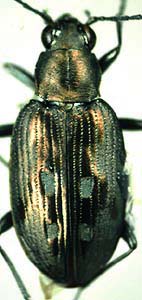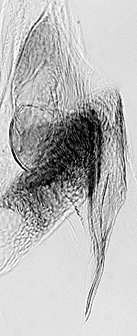Bembidion conicolle
David R. MaddisonAdult External Characteristics
Mirrors on intervals 2 through 7, outer mirrors broadly connected or isolated from inner mirrors. Pronotum only slightly basally constricted, relatively flat, generally with small carina, midlateral setae present or absent. Male protarsomere adhesive setae narrow.
Male Genitalia
Aedeagus narrower than in B. litorale, with less curved ostial sclerotized strip. Ventral Sclerite Patch large, with unscaled (but occasionally striated) dorsal ridge. Ostial microtrichial patch dense and narrow.
Comparison with Related Species
Compare with:
Very similar to B. litorale; they may be conspecific (see Maddison, 1993, for details). The main external differences are in the prothorax: that of B. conicolle is flatter, with straighter sides and a wider base; the midlateral seta is constantly absent in B. conicolle, only inconstantly so in B. litorale. Most B. conicolle have a minute basilateral carina on the pronotum, whereas it is absent in the observed B. litorale. The fourth elytral stria is generally straighter in B. conicolle (although in some specimens it is abruptly sinuate). The outer mirrors are broadly connected to the inner elytral mirrors in most, but not all, specimens of B. conicolle. Setae ed3 and ed5 are at the anterior margin of the silver spot in most specimens. For aedeagal differences, see Maddison (1993).
B. conicolle can be separated from the North American B. levettei by the lack of the prothoracic seta and the narrow protarsomere of the male in B. conicolle.
Geographic Distribution
An eastern Palearctic form, from the Lena River, Lake Baikal, and Mongolian Peoples' Republic, east to the Ussur region and Japan.
Nomenclature
- Bembidium conicolle Motschulsky 1845. Lectotype male in ZMUM.
- Bembicidium conicicolle Motschulsky 1850
- Bembidion baikalo-ussuricum Netolitzky 1940
Title Illustrations

| Scientific Name | Bembidion conicolle |
|---|---|
| Location | NE Siberia: Kolyma Inf., Fl. Omsuktschan |
| Specimen Condition | Dead Specimen |
| Sex | Male |
| Image Use |
 This media file is licensed under the Creative Commons Attribution License - Version 3.0. This media file is licensed under the Creative Commons Attribution License - Version 3.0.
|
| Copyright |
© 1995 David R. Maddison

|
About This Page
David R. Maddison

Oregon State University
Page copyright © 1995 David R. Maddison
 Page: Tree of Life
Bembidion conicolle .
Authored by
David R. Maddison.
The TEXT of this page is licensed under the
Creative Commons Attribution License - Version 3.0. Note that images and other media
featured on this page are each governed by their own license, and they may or may not be available
for reuse. Click on an image or a media link to access the media data window, which provides the
relevant licensing information. For the general terms and conditions of ToL material reuse and
redistribution, please see the Tree of Life Copyright
Policies.
Page: Tree of Life
Bembidion conicolle .
Authored by
David R. Maddison.
The TEXT of this page is licensed under the
Creative Commons Attribution License - Version 3.0. Note that images and other media
featured on this page are each governed by their own license, and they may or may not be available
for reuse. Click on an image or a media link to access the media data window, which provides the
relevant licensing information. For the general terms and conditions of ToL material reuse and
redistribution, please see the Tree of Life Copyright
Policies.
Citing this page:
Maddison, David R. 1995. Bembidion conicolle . Version 01 January 1995 (under construction). http://tolweb.org/Bembidion_conicolle/401/1995.01.01 in The Tree of Life Web Project, http://tolweb.org/









 Go to quick links
Go to quick search
Go to navigation for this section of the ToL site
Go to detailed links for the ToL site
Go to quick links
Go to quick search
Go to navigation for this section of the ToL site
Go to detailed links for the ToL site